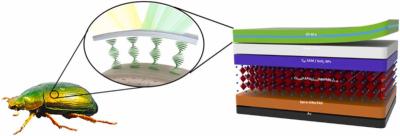Researchers develop colored perovskite solar cells inspired by beetles
Researchers from Kyung Hee University and Ulsan National Institute of Science and Technology (UNIST) in Korea have used cholesteric reflective screens, which were influenced by the skin of a beetle, to produce efficient and opaque perovskite solar cells. Unlike metal and oxide-based reflection screens, cholesteric reflective filters (ChRFs) are entirely composed of organic compounds and are much easier to design and implement.

For use in colored perovskite solar cells (PSCs), two distinct kinds of ChRFs were produced, each with a distinct cross-linking pattern (monolayer or bilayer). Since the color of the ChRFs varies depending on the angle of view, they can be utilized to make colored PSCs. As the reflective screens were created using only organic components and wet procedures, they can be used to build large and adaptable PSCs without the need for expensive suction methods.








